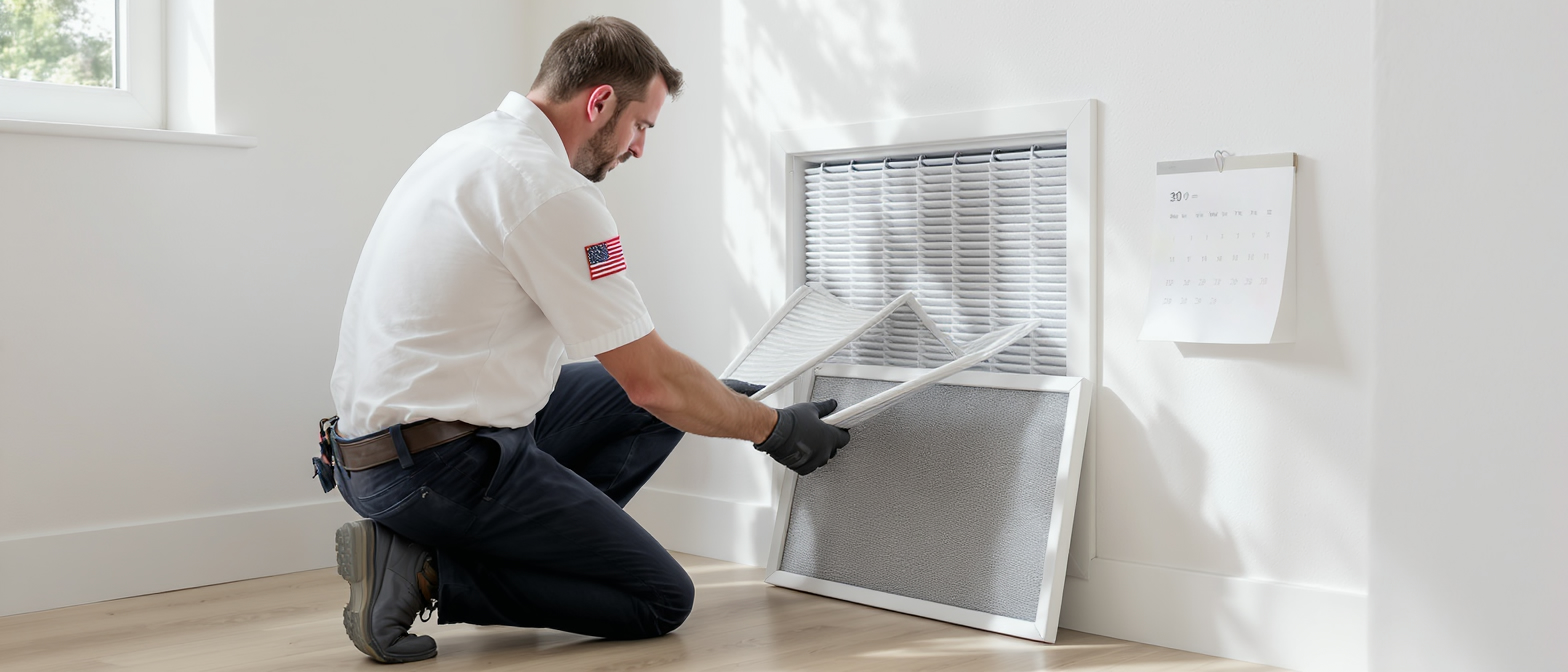How Often Should I Change My AC Filter?

Wondering “how often should I change my AC filter?” The short answer is: most homes need a fresh filter every 30–90 days, but your exact air filter change schedule depends on filter size, MERV rating, system type, how often you run the AC, and local conditions. In Southern California, dust, pollen, and wildfire smoke can shorten that timeline. Clean filters protect airflow, stabilize energy bills, and support healthy indoor air quality—our core mission is healthy air at home for a healthy life.
Quick answer by filter type
1-inch filter: typical home 30–60 days; with pets, allergies, smokers, or heavy use 20–45 days; vacation/part-time use 60–90 days.
2–3 inch filter: 45–90 days; with pets/allergies 30–60 days.
4-5 inch media filter: 90–180 days; with pets/allergies 60–90 days.
Ductless mini-split filter: rinse washable screens monthly; if your indoor head uses a cartridge, expect 3–6 months. Always power the unit off and follow the manufacturer manual. If you’re unsure, ask a qualified technician.
Commercial spaces: inspect monthly; many change every 30–60 days under high occupancy, open doors, or dusty operations.
What changes the schedule
MERV rating: higher MERV captures finer particles but can load faster. Match the MERV rating to your equipment’s specs to protect airflow and the blower.
Run-time: long cooling seasons or heat pump use means more frequent changes.
Home factors: pets, allergies/asthma, smoking, shedding carpets, or ongoing construction shorten intervals.
Outdoor environment: Santa Ana winds and wildfire smoke push more particulates through returning air.
Signs your air filter needs changing now
Visible gray or matted dust on the filter surface.
Weaker airflow from supply registers or rooms going warm.
Rising energy bills or longer cooling cycles.
More sneezing, itchy eyes, or dust accumulation.
Short cycling, musty odors, or a frozen coil on the indoor unit.
Southern California realities
Our region’s climate swings and air events affect AC filter replacement frequency. During summer heat waves, your system runs longer and the filter loads quicker. Coastal humidity, inland dust, construction debris, Santa Ana winds, and wildfire smoke can all shorten safe change intervals. After a smoke event, check your filter immediately; soot and odor particles saturate media fast.
What happens if you delay
Higher energy use as the fan works against a pressure drop.
Comfort issues—hot spots, reduced airflow, icing, and potential compressor stress.
Poor indoor air quality that aggravates allergies and asthma.
Premature wear on blowers and coils, and possible warranty or insurance concerns.
Important: many homeowners’ policies and equipment warranties expect regular HVAC maintenance performed or documented by a qualified specialist. DIY beyond simple filter swaps can be risky; opening sealed panels, misfitting high-MERV media, or running the system without a filter can damage equipment and may jeopardize coverage.
Choosing the right filter
Size: match the dimensions printed on your current filter or measure the return grille cabinet. A snug fit prevents bypass dust.
Orientation: install with the airflow arrow pointing toward the blower.
MERV: MERV 8–11 works for many homes; MERV 13 improves fine particle capture but only if your system is designed for it. When in doubt, consult a pro.
Ductless mini-split filter care: gently vacuum or rinse the washable screens monthly and fully dry before reinstalling. If your brand uses an add-on cartridge, follow the stated interval. For Fujitsu, Mitsubishi Electric, Midea, Gree, and Hier systems, check the factory manual for exact instructions.
When a professional is essential
If you experience recurring clogged filters, airflow imbalances, a frozen coil, or are considering higher-MERV or HEPA upgrades, that moves beyond a simple swap into system design territory. Complex homes, zoning, large residences, and commercial and residential HVAC sites often need engineered solutions: bigger return paths, media cabinets, pressure readings, or electronic filtration. Insurance requirements may also call for licensed documentation on maintenance and indoor air quality upgrades.
Who we are
#1 AC Guys is a fourth-generation family of engineers serving Los Angeles County and nearby areas, including Orange County, Ventura County, and Western Riverside County. We specialize in big and complex projects across commercial and residential HVAC. Our team brings 80+ years of engineering experience, and our engineers have trained at manufacturers’ factories: Fujitsu (Japan), Mitsubishi Electric (Thailand), Midea (China), Gree (China), and Hier (China). Our mission is healthy air at home for a healthy life.
Service area examples
Los Angeles County: Los Angeles, Long Beach, Pasadena, Santa Monica, Glendale, Burbank, Torrance.
Orange County: Anaheim, Irvine, Santa Ana, Huntington Beach, Costa Mesa, Fullerton.
Ventura County: Oxnard, Ventura, Thousand Oaks, Simi Valley, Camarillo.
Western Riverside County: Corona, Riverside (western areas), Temecula, Murrieta, Norco.
Safety notes
Never run your HVAC without a filter.
Replace immediately if the filter is wet, collapsed, or moldy; shut the system off and seek help.
Do not exceed the filter thickness or MERV rating recommended by the manufacturer.
Tasks involving sealed panels, electrical components, or refrigerant circuits should be left to qualified technicians.
Bottom line: check monthly, change as soon as the media looks loaded or the calendar says it’s due, and adjust for season, MERV, pets, and local air events. That routine protects comfort, efficiency, and the long-term health of your system and your indoor air.
Yasmine is currently an Associate Professor of Psychology at Mount Saint Mary College where she teaches a wide array of courses in the Psychology department. She is a Fulbright Scholar spent a year working at the Medical Decision Making Center at Ono Academic College in Israel.
Yet, as many higher education professionals can surely attest to, I have also witnessed the other challenge in group decision making. In academia, engaging in critical dissent is encouraged (reviewed by Jetten & Hornsey, 2014), and while this is a fine attribute, practically,
